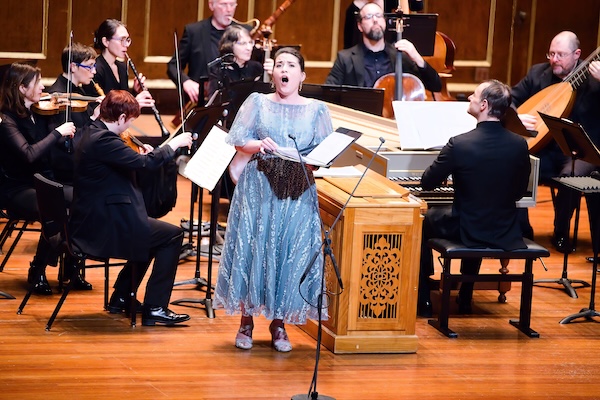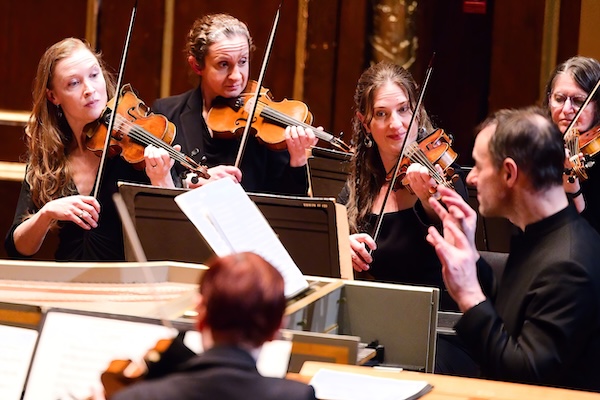Concert Review: Handel + Haydn Society Explores the Romantic Music of Young Handel
By Aaron Keebaugh
This H + H Society performance suggested Handel’s genius for generating joy.

Soprano Joélle Harvey with the H+H Orchestra. Photo: Hilary Scott
When one thinks of Handel, the composer’s many operas and oratorios come to mind in all their lyrical glory.
Yet the style Handel cultivated in England sprang from his youthful ventures in Italy, where he honed his craft in setting dramatic tales of love and loss through an equally vivid and florid musical language.
Too often, though, the more than 100 cantatas Handel composed while working in Rome rarely make their way onto concert programs. Choral societies and musical organizations tend to favor the large-scale and more popular works of his later years.
Leave it to the Handel + Haydn Society to heap renewed attention on a side of Handel rarely explored. Earlier this month, conductor Jonathan Cohen, soprano Joélle Harvey, and the H+H period instrument orchestra served up the varied emotional tensions of two early Handel cantatas that tell of love gone wrong.
Italian cantatas of the 17th and 18th century were quite different from the sacred works so familiar to the ones Bach brought to German churchgoers every Sunday. Predominantly secular, Italian cantatas were often dramatic in style and sometimes they were even staged. And, given Handel’s affinity for vocal flourishes, they routinely showcased a stellar singer.
This H + H performance was highlighted by the return of soprano Joélle Harvey. A frequent guest of the ensemble, Harvey channeled the pain of love and loss in Handel’s Delirio amoroso and Tra le fiamme. The plot of the former cantata mirrors the legend of Orpheus. Cardinal Benedetto Pamphili’s libretto relates the story of Chloris, who loves Thyrsis and mourns his death. But Thyrsis does not return Chloris’s affections — even after she descends into Hell to save him. She still pities him — regardless of her heartbreak — and she leads him to the Elysian Fields.
Harvey cultivated every emotional shade of this unreciprocated affair. Fervent melismas and vocal trills, injected with live-wire intensity, evoked heartbreak as well as the woman’s dutiful exuberance. In “Un pensiero voli in ciel,” Harvey and concertmaster Aisslinn Nosky dovetailed their combined phrases into a weave of rapt splendor, capturing the text’s emotional fire.

Artistic Director Jonathan Cohen conducts the H+H Orchestra in Love, Handel. Photo: Hilary Scott
Harvey’s character registered second thoughts in “Ma fermati, pensier, pur troppo è vero,” which tipped her character’s emotional state momentarily toward darkness. Throughout the number, Cohen performed on harpsichord and organ, joining the low strings in a supple and sensitive continuo. Soft chords framed Harvey’s bright lyricism in “Non ti bastava” where she expressed regret over being scorned.
Other vocal passages offered opportunities to make this performance an aria-lover’s dream. “Lascia omai le brune vele” showcased Harvey’s deft control of octave leaps. Her voice still carried weight and vitality even at a whisper. The concluding “In questo amene” coursed with vigor.
Pamphili’s libretto for Tra le fiamme draws parallels between the story of Daedalus and Icarus and the fate of butterflies who fly too close to flames. Both dramas were used to symbolize the dangers of love. This interweaving of myth and insects may have been meant to serve as a warning to Handel, who was rumored to have been in a relationship with Vittoria Tarquini, a singer who was mistress to Prince Ferdinando de Medici.
H+H’s performance conveyed plenty of inner turmoil. The orchestral accompaniment seesawed between extremes, skillfully framing the musical dialogue between Harvey and viola da gambist Matt Zucker. Leading it all, Cohen drew on a remarkable ability to generate musical excitement — even on an atomic level. Rhythms were hit sharply, retaining their crispness even in the piece’s lyrical sections, which flowered beautifully. The music always danced. The florid lines of “Pien di nuovo e bel diletto” managed to soar. Harvey and Zucker channeled real Baroque fire in “Voli per l’aria,” which follows the doomed flight of Icarus.
A similar approach was taken for Handel’s Concerto Grosso, Op. 6, No. 1, which rounded out the program. There was terpsichorean zest here as well, the crisp rhythms registered like jolts to the ears. Nosky and violinist Christina Day Martinson played the solo parts with equal conviction over the supple accompaniment, driven by Cohen and cellist Guy Fishman. If the fugal section could have used a little more clarity, the final Gigue bounded with an urgent resplendence.
Cohen opened the concert by leading the H+H Youth Choruses Chamber Choir in two popular Handel choruses. In both, the young singers conveyed dramatic urgency. While “O Love Divine” from Theodora compelled via its dolorous weight, the punch and pizzazz of “Happy We!” from Acis and Galatea set the air spinning. Handel’s music expresses myriad emotions. But this performance suggested Handel’s genius for generating joy.
Aaron Keebaugh has been a classical music critic in Boston since 2012. His work has been featured in the Musical Times, Corymbus, Boston Classical Review, Early Music America, and BBC Radio 3. A musicologist, he teaches at North Shore Community College in both Danvers and Lynn.
